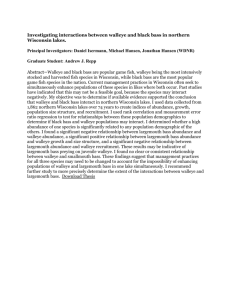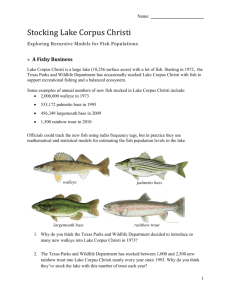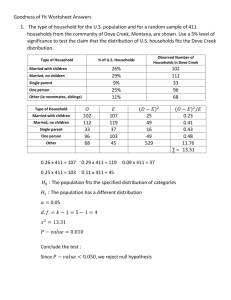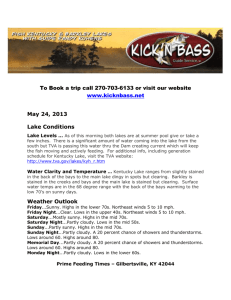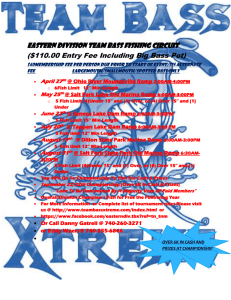Fish Survey and Aquatic Assessment Report for Horsehead Lake
advertisement
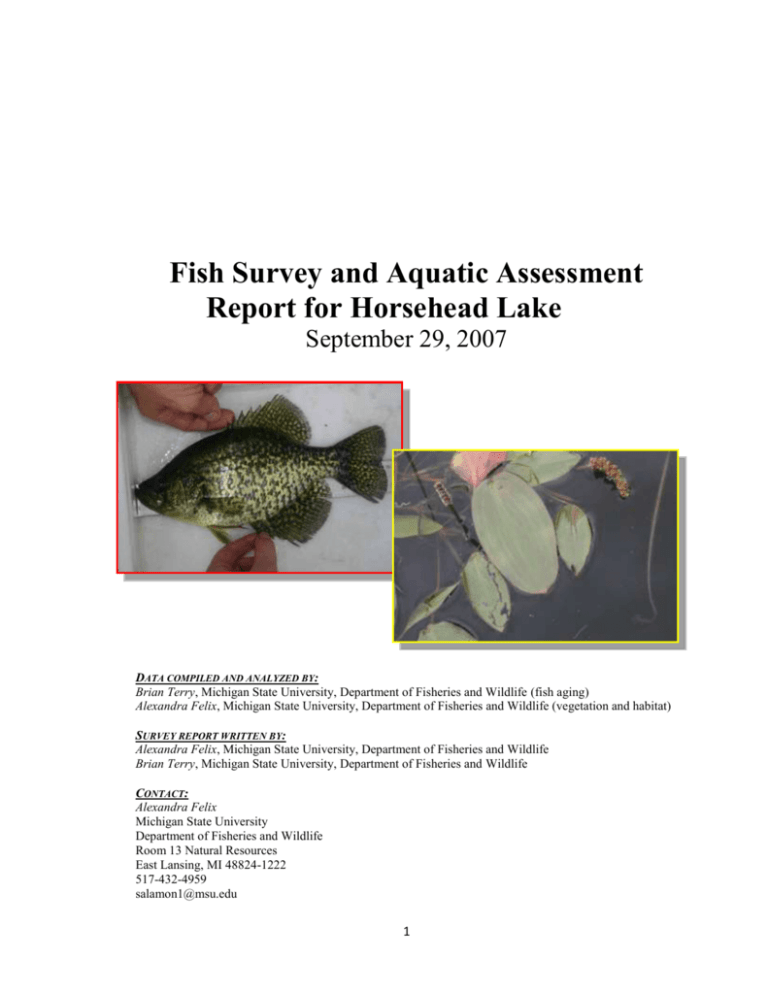
Fish Survey and Aquatic Assessment Report for Horsehead Lake September 29, 2007 DATA COMPILED AND ANALYZED BY: Brian Terry, Michigan State University, Department of Fisheries and Wildlife (fish aging) Alexandra Felix, Michigan State University, Department of Fisheries and Wildlife (vegetation and habitat) SURVEY REPORT WRITTEN BY: Alexandra Felix, Michigan State University, Department of Fisheries and Wildlife Brian Terry, Michigan State University, Department of Fisheries and Wildlife CONTACT: Alexandra Felix Michigan State University Department of Fisheries and Wildlife Room 13 Natural Resources East Lansing, MI 48824-1222 517-432-4959 salamon1@msu.edu 1 INTRODUCTION As a follow-up to research conducted in June 2007 on fish population characteristics at Horsehead Lake, a team from Michigan State University partnered again with Horsehead Lake Association to conduct an additional fish survey and habitat assessment. In the survey conducted earlier this year, trap nets were used as the primary means of collecting data on fish species. Due to unseasonably warm weather and variable ecological conditions, however, the Michigan State University team suggested expanding the research and advancing our understanding of the ecology of Horsehead and John Brown Lakes. Additional information the Association wanted to obtain included better data on fish population characteristics, and habitat characteristics including percent aquatic vegetation cover, changes in vegetation cover from previous assessments, relationship of aquatic cover and structure to fish habitat quality, and the potential of Horsehead Lake and the John Brown lakes to support largemouth bass, panfish, northern pike, and walleye. Therefore, we designed another study to collect fish population data using electrofishing, and we conducted a vegetation and fish habitat assessment. The information gained will help the lake association manage the fishery of Horsehead and John Brown Lakes according to its ecological potential. Fish Population Assessment To supplement data collected in June 2007, we used electrofishing to sample the fish populations in Horsehead and John Brown Lakes. Our objective for the survey was to identify fish species presence in Horsehead Lake, and assess length, age, and growth trends of fish to provide lake association members and residents with data that can be used to help identify fish management goals. Vegetation and Fish Habitat Assessment Structure and availability of aquatic vegetation are important components of fish habitat and may influence reproductive success and/or survivability. For instance, northern pike spawn in areas of dense (>80% cover) aquatic vegetation on which eggs can adhere (Inskip 1982). Embryos cannot survive if eggs drop to the substrate. Similarly, bluegill and other panfish need aquatic vegetation as hiding cover from predators. 2 Vegetation however, is not the only factor contributing to habitat suitability for fish. Other factors such as water temperature, water depth, amount of dissolved oxygen, pH, and water transparency also contribute to the suitability of a lake as habitat for different fish species. Nevertheless, a careful assessment of aquatic vegetation structure, composition, and distribution in the lake can help us understand the potential of Horsehead Lake to provide spawning areas and cover for various fish species present. Our objectives for the vegetation assessment were the following: 1) To determine the structure, composition (i.e., presence of exotic species), and spatial distribution (location) of vegetation in Horsehead Lake, Big John Brown Lake, and Little John Brown Lake. 2) Relate vegetation characteristics to spawning habitat suitability and cover suitability for bluegill, perch, crappie, largemouth bass, northern pike, and walleye. METHODS Fish Population Assessment The fish survey was conducted throughout the day on Saturday September 29, 2007. Dr. Mary Bremigan, a Professor from the Fisheries and Wildlife Department at Michigan State University was the captain of the electrofishing boat. Electrofishing works by sending a field of electricity through the water that triggers a muscle reaction from the fish, resulting in them becoming motionless for several seconds. During the time interval when the fish are motionless, they are hand netted and temporarily stored in a holding tank on the boat until they can be processed (Figure 1). The boat was launched around 8:00 am and traveled throughout Horsehead and John Brown Lakes. Students in the Michigan State Fisheries and Wildlife Club and Horsehead Lake Association members helped with the collection of data. Recorded information included fish species, total length (mm), and location of catch. A few scales were also removed and so that we could determine the age of each fish at a later date. All fish were then released immediately following processing. For the data analysis, we compared average length and growth of our sampled fish to those of state averages. 3 Figure 1. Electrofishing boat used to conduct a fish survey at Horsehead Lake on September 29, 2007. Vegetation and Fish Habitat Assessment We established a grid on the lakes, on which sampling points were placed approximately 150 feet apart. Measurements taken at these points indicated vegetation conditions in the interior of the lakes. We then traveled by boat within 150 feet of the shoreline to obtain more precise measurements of vegetation and substrate conditions in the shallow water (i.e., < 3 feet deep) where spawning for many fish species is likely to occur. Information we recorded included GPS coordinates of sampling points, whether water depth was < 5 feet deep, percent cover of vegetation, structure (e.g., submergent, emergent, floating), presence of woody debris, substrate type (e.g., silt, sand, gravel, rock), and presence of exotic plant species. Measurements were taken at approximately 300 points in the lakes. 4 Once data were collected, they were downloaded onto a computer software program called ArcView 3.2 Geographic Information Systems (GIS) that allowed us to conduct spatial analyses of the lake data and make maps of vegetation cover, substrate characteristics, and fish habitat. To make the maps, we interpolated values between the actual sampling points using a method called Inverse Distance Weighting. We also used habitat suitability index models for the fish species of interest to determine areas of the lake that have high versus low suitability for fish spawning habitat and cover. A summary of preferred vegetation and substrate conditions for different fish species is provided in Table 1. 5 Table 1. Preferred vegetation and substrate conditions for fish species found in Horsehead and John Brown lakes. Fish species Bluegill Crappie Largemouth bass Northern pike Perch Walleye Spawning depth < 1 meter * * < 1 meter * * % vegetation cover 20-40 25-80 % cover from woody debris > 10% % of lake littoral (< 15 ft) 20-60% 15-75% Substrate composition sand/ fine gravel * > 25% 25-75% 15-25% 25-40% gravel/silt * gravel or woody coarse gravel/rock 30-60 >80 25-50 * Condition was not specified. 6 Reference Stuber et al. 1982a Edwards et al. 1982 Stuber et al. 1982b Inskip 1982 Krieger et al. 1983 McMahon et al. 1984 RESULTS and DISCUSSION Fish Population Assessment A total of 129 fish comprising 10 species were caught in Horsehead and John Brown lakes during the fall survey: bluegill (n = 23), bowfin (n = 2), brown bullhead (n = 1), crappie (n = 1), central mudminnow (n = 10), largemouth bass (n = 37), northern pike (n = 2), perch (n = 44), pumpkinseed sunfish (n = 7), and rock bass (n = 2). Both the spring and fall surveys combined yielded 453 fish comprising 12 species. Although data were collected from 3 different sampling methods (hook and line, fyke nets, and electrofishing), estimates of relative abundance may be weak due to lack of representation of some species or bias in data collection. At best, we can estimate that 50–70% of the fish are comprised of bluegill and sunfish species, approximately 10% of the fish population is perch, 12–15% is largemouth bass, 5% is pike, 5– 10% is comprised of other species (e.g., bowfin, bullhead), and there is a very low percentage of walleye and smallmouth bass in the lake. Estimates should be validated and/or adjusted with continued monitoring and data collection. Bluegill Most of the bluegill caught with electrofishing were in the 1-year age class, which was expected (Table 2). Not many fish > 6-years old were captured, and the maximum age captured was 7-years-old. The average length for bluegill in Horsehead and John Brown lakes was less than that of the state average for bluegill in the 3-year, 4-year, 5-year, 7-year, and 8-year age classes (Figure 2). The differences between state average length and length recorded for Horsehead and John Brown lakes were statistically significant. (Note: significance is represented by the error bars on the graph. These bars represent the amount of variability in the sample of fish we caught. If the bars overlap the state average length, then the difference between the length of fish we sampled was not significantly [statistically] different than the state average). The data show that bluebill < 2-years old are growing at or near state average rates (Figure 2). These trends are consistent with those observed with the spring 2007 survey. 7 Table 2. Number and percent of individual bluegill sampled in different age classes. Length was recorded in mm, but also reported in inches. S.E. indicates standard error, a measure of variability. Bluegill Age n Mean Length (mm) S.E. Length (inches) 0 3 64.33 4.25 2.53 1 6 82.83 1.30 3.26 2 2 99.50 6.50 3.92 3 3 128.00 4.58 5.04 4 2 144.00 1.00 5.67 5 2 168.00 1.00 6.61 6 3 179.66 2.84 7.07 7 2 188.50 1.50 7.42 Total (N)= 23 Bluegill 250.00 Length (mm) 200.00 150.00 State Avg Mean Length 100.00 50.00 0.00 0 1 2 3 4 5 6 7 8 Age (years) Figure 2. Comparison between mean length of bluegill in Horsehead and John Brown lakes to Michigan state average length for different age classes. Data for Horshead and John Brown lakes were collected in September 2007. 8 Largemouth Bass All age classes of largemouth bass were captured during electrofishing Table 3, Figure 3). Even though all age classes of bass were captured, observers on the electrofishing boat noted that many larger specimens of bass swam off before they could be netted. Table 3. Number of individual largemouth bass sampled in different age classes. Length was recorded in mm, but also reported in inches. S.E. indicates standard error, a measure of variability. Largemouth Bass Age n Mean Length (mm) S.E. Length (inches) 0 4 69.25 8.34 2.73 1 2 110.00 5.00 4.33 2 6 178.33 7.75 7.02 3 10 236.00 6.75 9.29 4 4 283.25 11.06 11.15 5 5 328.40 1.96 12.93 6 4 358.25 7.67 14.1 7 1 390.00 15.35 8 1 422.00 16.61 Total (N)= 37 9 Length (mm) Largemouth Bass 500.00 450.00 400.00 350.00 300.00 250.00 200.00 150.00 100.00 50.00 0.00 State Avg Mean Length Spring/Fall combined 0 1 2 3 4 5 6 7 8 9 Age (years) Figure 3. Comparison between mean length of largemouth bass in Horsehead and John Brown lakes to Michigan state average length for different age classes. Mean length data for Horshead and John Brown lakes were collected in September 2007. The combined data included data from the fall survey as well as the one conducted in June 2007. According to the fall survey, the average length for largemouth bass in different age classes in Horsehead and John Brown lakes was less than the state average (Figure 3). Because there may have been a capture bias during electrofishing toward smaller bass (as noted by netters on the electrofishing boat), these results may not be accurate. Combined data for fish surveys conducted in spring 2007 and fall 2007 indicate that the largemouth bass population is growing at or near state averages. Yellow Perch Yellow perch were captured by electrofishing in all age classes from 0 to 7 years except for the 5-year class (Table 4, Figure 4). Perch are primarily a deeper dwelling fish, but may migrate to shallower environments to feed. Data indicated that the perch in Horsehead and John Brown lakes are growing at or near state averages (Figure 4). 10 Table 4. Number of individual yellow perch sampled in different age classes. Length was recorded in mm, but also reported in inches. S.E. indicates standard error, a measure of variability. Yellow Perch Age n Mean Length (mm) S.E. Length (inches) 0 9 72.66 3.49 2.86 1 16 112.62 3.07 4.43 2 4 143.00 5.87 5.63 3 8 179.25 1.88 7.06 4 3 203.66 2.02 8.02 5 0 6 3 249.00 3.00 9.80 7 1 267.00 Total (N)= 10.51 44 Yellow Perch 300 Length (mm) 250 200 State Avg 150 Mean Length 100 50 0 0 1 2 3 4 5 6 7 8 Age (years) Figure 4. Comparison between mean length of yellow perch in Horsehead and John Brown lakes to Michigan state average length for different age classes. Data on mean length were collected in September 2007. 11 Pumpkinseed The number of pumpkinseed caught was lower than those caught in the study conducted in late May and early June earlier this year (2007). Only 7 individuals in the 2-year, 4-, 5-, 6-, and 7-year age classes were caught (Table 5, Figure 5). The lower capture rate could be due to the fact that they are benthos feeders, feeding primarily on snails and invertebrates and may be more likely to swim into a fyke net lead than be captured from electrofishing. The results from the fall 2007 survey (Figure 5), the spring 2007 survey, and previous surveys indicated that pumpkinseed sunfish are generally growing at least as well as state average rates, especially in older age classes. Table 5. Number of individual pumpkinseed sunfish sampled in different age classes. Length was recorded in mm, but also reported in inches. S.E. indicates standard error, a measure of variability. Pumpkinseed Age n 0 0 1 0 2 1 3 0 4 Mean Length (mm) S.E. Length (inches) 105 4.13 1 133 5.24 5 2 162 6 1 177 7 2 190 Total (N)= 4 6.38 6.97 0 7 12 7.48 Pumpkinseed 200.00 180.00 Length (mm) 160.00 140.00 120.00 State Avg 100.00 Mean Length 80.00 60.00 40.00 20.00 0.00 0 1 2 3 4 5 6 7 8 Age (years) Figure 5. Comparison between mean length of pumpkinseed sunfish in Horsehead and John Brown lakes to Michigan state average length for different age classes. Data were collected in September 2007. Vegetation and Fish Habitat Assessment Aquatic Vegetation Approximately 34% of Horsehead and John Brown lakes is sparsely (< 25%) vegetated or is too deep (> 15 feet) to be considered in the littoral zone. Sparse submerged vegetation occurs along much of the shoreline (Figure 6a). Areas with 25–50% submergent cover comprise 26% of the lakes, and mostly occur approximately 100 feet offshore along the northern and eastern part of the Horsehead Lake, and in the shallow parts of the southern portion of the lake (Figure 6a). Areas with 50–75% vegetation cover comprise approximately 33% of the lake and include the John Brown lakes and the northern portion of Horsehead Lake (Figure 6a). Areas with emergent and floating vegetation have decreased since the 1940’s survey, because more houses have developed along the lake and cleared areas for docks and boats (Figure 6b) No 13 exotic plant species were found in the lake during the survey; however monitoring should continue for the presence of Eurasian water milfoil and curly leaf pond weed. Substrate The majority of Horsehead Lake has a sandy substrate, whereas the John Brown lakes are dominated by silt (Figure 7). Some areas of Horsehead Lake contain a silty substrate, including shallow areas near the sunken island and areas along the southwestern shoreline. The northern part of Horsehead Lake has a significant amount of silt substrate, as well. Very few areas contain gravel or rock; these areas occur near some of the islands and near the narrow part of Horsehead Lake (Figure 7). Bluegill habitat Areas with optimal cover (20–40%) for bluegills occur in the southern part of Horsehead Lake and approximately 100 feet off the eastern shore of Horsehead Lake (Figure 8). The northern part of Horsehead Lake and the John Brown lakes also provide relatively high cover suitability for bluegill. In those areas, survival of bluegill is likely higher due to more hiding cover, however smaller bluegill may also occur in those areas due to overabundance from low predation rates (i.e., high cover inhibits predation from visual predators such as largemouth bass). Bluegill are spawning habitat generalists. Although spawning will occur over almost any substrate, fine gravel or sand is preferred (Stevenson et al. 1969). Because much of the substrate in Horsehead Lake is sand, bluegill do not seem to be limited by spawning areas. Overall vegetation structure and availability of spawning areas is suitable for bluegill in Horsehead and John Brown lakes. Neither appear limiting for survival and reproduction of this species. Crappie habitat The distribution of areas with preferred cover for crappie looks similar to that of bluegill, but crappie prefer a wider range of percent cover conditions than bluegill (Figure 9). Suitable percent cover occurs between 25–80% (Edwards et al. 1982). Approximately 36% of the lakes provides optimal cover conditions for crappie. 14 Crappie spawn over a variety of substrates; determining factors for spawning include water clarity and presence of submersed vegetation. Thus, Horsehead and John Brown lakes do not appear limiting for crappie spawning areas and cover. Research suggests that quantity and quality of food may limit crappie abundance if cover and spawning habitat are not limiting (Edwards et al. 1982). Largemouth bass habitat Based on the population assessments, largemouth bass appear to be growing at or above state average growth rates, which is likely due, in part, to good habitat conditions. Approximately 50% of the lake provides excellent cover conditions for largemouth bass (Figure 10). Although largemouth bass prefer to spawn over gravel substrate, silt and sand also provide good and moderate spawning habitat, respectively (Stuber et al. 1982). Habitat does not appear limiting in Horsehead and John Brown lakes for largemouth bass. Yellow perch habitat Perch, like bluegill, prefer areas with moderate (25–50%) vegetation cover (Krieger et al. 1983). Research has shown that their abundance is directly related to the amount and quality of cover including vegetation, woody debris, brush, and standing timber because preferred prey items such as insects and small fish are associated with cover (Krieger et al. 1983). During the electroshocking survey, a greater proportion of perch were found near the islands and parts of the lake where the substrate was gravelly and tree roots or some woody debris was available. The habitat map reflects where perch were prevalent (Figure 11). Northern pike habitat The availability of dense (> 80%) cover of submersed vegetation is directly related to the suitability of areas as spawning habitat for pike (Inskip 1982). Young northern pike also depend on vegetation for protective hiding cover and on the associated invertebrate fauna and prey fish for food (Inskip 1982). There appears to be adequate pike habitat in Horshead and John Brown lakes (Figure 12). The best cover for pike occurs in the small bays and the northern part of Horsehead Lake, and in the John Brown lakes. Habitat does not appear limiting for pike. 15 Walleye habitat The main factors affecting walleye reproductive success include water temperature regime, and availability of gravel, rocks, rubble, or boulders in shallow (0.3–1.5 m) water for spawning (McMahon et al. 1980). Rocks are necessary because eggs are protected as they fall in cracks and crevices between rocks. It is evident that Horsehead Lake is limiting for walleye spawning habitat (see substrate Figure 7). Other lake characteristics such as depth, extensive littoral areas, and productivity may be adequate to provide food resources for walleye; however, those characteristics were not measured during this survey. 16 A.) Percent Cover 100% B.) Key Emergent Floating 0% Figure 6. Percent cover of submersed aquatic vegetation (A) and location of emergent and floating vegetation (B) in Horsehead and John Brown Lakes, Mecosta County, Michigan. 17 SUBSTRATE CHARACTERISTICS N Fine gravel Sand/silt Figure 7. Substrate characteristics in Horsehead and John Brown Lakes, Mecosta County, Michigan. 18 BLUEGILL COVER SUITABILITY N Suitability score 1.0 0.0 Figure 8. Cover suitability for bluegill in Horsehead and John Brown Lakes, Mecosta County, Michigan. Suitability was determined on a scale of 0 to 1; 1 represents highest suitability. 19 CRAPPIE COVER SUITABILITY N Suitability score 1.0 0.0 Figure 9. Vegetation cover suitability for crappie in Horsehead and John Brown Lakes, Mecosta County, Michigan. Suitability was determined on a scale of 0 to 1; 1 represents highest suitability. 20 LARGEMOUTH BASS COVER SUITABILITY N Suitability score 1.0 0.0 Figure 10. Vegetation cover suitability for largemouth bass in Horsehead and John Brown Lakes, Mecosta County, Michigan. Suitability was determined on a scale of 0 to 1; 1 represents highest suitability. 21 PERCH COVER SUITABILITY N Suitability score 1.0 0.0 Figure 11. Vegetation cover suitability for perch in Horsehead and John Brown Lakes, Mecosta County, Michigan. Suitability was determined on a scale of 0 to 1; 1 represents highest suitability. 22 NORTHERN PIKE COVER SUITABILITY N Suitability score 1.0 0.0 Figure 12. Vegetation cover suitability for pike in Horsehead and John Brown Lakes, Mecosta County, Michigan. Suitability was determined on a scale of 0 to 1; 1 represents highest suitability. 23 MANAGEMENT RECOMMENDATIONS According to the 1997 survey conducted by the Michigan Department of Natural Resources, and the spring and fall 2007 surveys conducted by Michigan State University and the Horsehead Lake Association, size and growth of largemouth bass and panfish (with the exception of bluegill) is better than state average. We didn’t collect enough pike to assess growth; and we collected 0 walleye in fyke nets, by hook and line, or by electrofishing, which suggests a small population. According to the 2007 habitat assessment, areas of Horsehead and John Brown lakes provide suitable habitat for all desired fish species, with the exception of walleye. [Smallmouth bass is apparently also desired, but walleye currently represent a higher management goal by the Association.] The limiting factor for walleye in regards to habitat is the lack of coarse gravel or rubble for spawning (i.e., the substrate is mostly sand or silt); however, it may be costly and possibly ineffective to add gravel, rubble, and boulders to areas of Horsehead and John Brown lakes. Lack of walleye spawning habitat is common in many inland lakes without rocks exposed from wind or wave action, which is why self-sustaining walleye populations are generally rare in small inland lakes (Johnson et al. 1977). Habitat conditions only partially explain the observed fish population and growth trends in Horsehead and John Brown lakes. Current management activities explain the rest. The Horsehead Lake Association currently stocks bluegill, hybrid bluegill, and walleye in an attempt to maintain a healthy population of large panfish and increase the walleye population size. Although maintaining a healthy population of largemouth bass and northern pike are also goals of the association, stocking of these species does not currently occur (i.e., pike has not been stocked since 1990). Current management practices, however, conflict with the desired outcomes specified by the lake association. For instance, the lower-than-average growth of bluegills can result from poor habitat conditions (i.e., excessive aquatic plant cover) or overabundance. The results of this study indicated that habitat conditions are, in fact, suitable for bluegill. Therefore, the bluegill population is probably overabundant. In a natural environment, populations usually increase and stabilize at a level that is commonly referred to as the “carrying capacity,” which is the maximum density an ecosystem 24 can sustain. At the carrying capacity, the amount of food and cover resources available to each individual for growth and maintenance is “maxed out”. In other words, there are no surplus resources available and individual grown slows or ceases, thus resulting in smaller individuals. This pattern is evident in Horsehead and John Brown lakes. Usually a natural predator (such as largemouth bass) preys on the bluegill and reduces the bluegill population below carrying capacity, where there are more food and cover resources available to each individual, which results in faster growth rates and larger fish. However, addition of more bluegill to the lake through stocking increases population numbers and results in bluegill populations at or above the natural carrying capacity. Subsequently, competition increases as food and cover resources per individual become or remain limiting, growth slows or ceases, and fish are small (or at least smaller than average). To complicate things, stocking increases the food base for largemouth bass populations beyond what the lake would naturally produce and support. In a natural system, the largemouth bass would prey on bluegill until the bluegill population size decreased to a level where they were difficult for the bass to find. Additionally, the proportion of large (> 6-inch) bluegill would increase with the larger bass population (Guy and Willis 1990) because more food would be available per bluegill, which would result in faster growth. At this point, the bass population would decline and the bluegill population would begin to increase again and provide more food for the bass. This cycle would continue over time. In a lake stocked with bluegill, largemouth bass populations are generally large, and bluegills may be smaller than average (Guy and Willis 1990). To further complicate things, the lake association stocks walleye. Research indicates that predatory or competitive interactions exist between largemouth bass and walleye (Fayran et al. 2005), and northern pike and walleye (Nate et al. 2003), although stronger interactions seem to occur more frequently between largemouth bass and walleye than between pike and walleye (Fayran 2005). Several studies have documented an inverse relationship between largemouth bass and walleye densities (Inskip and Magnuson 1983, Santucci and Wahl 1993, Nate et al. 2003, Fayran et al. 2005). In other words, largemouth bass prey on walleye; thus, the more bass there are, the lower the survival rate for walleye. Therefore, stocking of walleye increases the largemouth bass food base and further promotes growth of bass population, which in turn 25 decreases survivability of young, stocked walleye (Kershner et al. 1999, Yako et al. 2000, Miranda and Pugh 1997). [Note: a bit of good news is that researchers have found no significant interactions between largemouth bass and pike (Soupir et al. 2000)]. Based on the literature and findings of this study, we recommend refraining from stocking bluegills in order to increase bluegill growth rates and decrease the size of the bass population. Decreasing the bass population size is especially critical to increase survivability of stocked walleye < 2 inches long. Because largemouth bass predation on stocked walleye is related to length of stocked walleye (Fayran 2005), we recommend stocking larger (6 inch) walleye fingerlings in the fall if a continued goal is to maintain a walleye fishery. Stocking rates of 6–8-inch walleye fingerlings range from 10–20 per acre based on information found in the literature, but data collection on growth rates and survival is necessary to determine optimal rates for specific lakes. Management of walleye and largemouth bass in the same water body is difficult, and maintenance of walleye is minimally effective in lakes with moderate to large populations of largemouth bass (Fayran 2005). If planted, smallmouth bass may also contribute to mortality of walleye, as smallmouth bass prey on walleye (Johnson and Hale 1977). The food base for walleye (i.e., yellow perch, minnows, darters, and invertebrates) in Horsehead Lake currently appears adequate; therefore, the factor most likely limiting walleye populations in Horsehead and John Brown lakes is largemouth bass predation. Thus, to be most effective in meeting the goals of the Horsehead Lake Association, it is critical to cease stocking bluegill and/or hybrid sunfish. Population estimates of species occurring in Horsehead and John Brown lakes would be beneficial for monitoring effects of management actions on the lake ecosystem and individual fish species. Nature has a way of keeping things in balance. To maintain healthy ecosystems, sometimes the best management strategy is to allow natural ecological processes to occur; however, natural ecosystems may not have the potential to support desired game fish and stocking is necessary to accomplish goals. Thus it is important to understand the ecology of the lake where stocking is to occur and understand the interactions between natural and stocked species. Regardless of the action chosen, monitoring habitat, water quality, and fish populations 26 is critical to determine how well management is meeting the objectives of the Horsehead Lake Association. In summary, management recommendations are 1) Refrain from stocking bluegill or hybrid sunfish 2) Stock 6-inch walleye fingerlings in the fall at a density of 10–20 per acre 3) Continue monitoring populations of all fish species in the lakes through creel surveys or other methods 4) Adapt management plans according to new information gained from monitoring 27 LITERATURE CITED Edwards , E. A., D. A. Krieger, G. Gebhart, and O. E. Maughan. 1982. Habitat suitability index models: Crappie. U.S.D.I. Fish and Wildlife Service. FWS/OBS-82/10.7. Fayran, A. H. 2005. Walleye stocking in Wisconsin lakes: species interactions, changes in angler effort, optimal stocking rats, and effects on community maturity. PhD Dissertation, University of Wisconsin-Madison, Madison, WI, USA. Fayran, A. H., M. J. Hansen, and T. J. Ehlinger. 2005. Interactions between walleyes and four fish species with implications for walleye stocking. North American Journal of Fisheries Management 25: 1321–1330. Guy, C. S. and D. W. Willis. 1990. Structural relationship of largemouth bass and bluegill populations in South Dakota ponds. North American Journal of Fisheries Management 10: 338– 343. Johnson, F. H. and J. G. Hale. 1977. Interrelations between walleye (Stizostedion vitreum vitreum) and smallmouth bass (Micropterus dolomieui) in four northeastern Minnesota Lakes. Journal of the Fisheries Research Board of Canada 34: 1626–1632. Johnson, M. G., J. H. Leach, C. K. Minns, and C. H. Oliver. 1977. Limnological characteristics of Ontario Lakes in relation to associations of walleye (Stizostedion vitreum vitreum), northern pike (Esox lucius), lake trout (Salvelinus namaycush), and smallmouth bass (Micropterus dolomieui). Journal of Fisheries Board of Canada 34: 1592–1601. Kershner , M. W., D. M. Schael, R. L. Knight, R. A. Stein, and E. A. Marschall. 1999. Modeling sources of variation for growth and predatory demand of Lake Erie walleye (Stizostedion vitreum), 1986-1995. Canadian Journal of Fisheries and Aquatic Sciences 56: 527– 538. Krieger, D. A., J. W. Terrell, and P. C. Nelson. 1983. Habitat suitability index models: Yellow perch. U.S.D.I. Fish and Wildlife Service. FWS/OBS-82/10.55. Inskip, P. D. and J. J. Magnuson. 1983. Changes in fish populations over an 80-year period: Big Pine Lake, Wisconsin. Transactions of the American Fisheries Society 112: 378–389. Inskip, P. D. 1982. Habitat suitability index models: Northern pike. U.S.D.I. Fish and Wildlife Service. FWS/OBS-82/10.17. McMahon, T. E., J. W. Terrell, and P. C. Nelson. 1984. Habitat suitability index models: Walleye. U.S.D.I. Fish and Wildlife Service. FWS/OBS-82/10.56. 28 Miranda, L. E. and L. L. Pugh. 1997. Relationship between vegetation coverage and abundance, size, and diet of juvenile largemouth bass during winter. North American Journal of Fisheries Management 17: 601–610. Nate, N. A., M. A. Bozek, M. J. Hansen, C. W. Ramm, M. T. BRemigan, and S. W. Hewett. 2003. Predicting the occurrence and success of walleye populations from physical and biological features of northern Wisconsin lakes. North American Journal of Fisheries Management 23: 1207–1214. Santucci, V. J., Jr. and D. H. Wahl. 1993. Factors influencing survival and growth of stocked walleye in a centrarchid-dominated impoundment. Canadian Journal of Fisheries and Aquatic Sciences 50: 1548–1558. Soupir, C. A., M. L. Brown, and L.W. Kallemeyn. 2000. Trophic ecology of largemouth bass and northern pike in allopatric and sympatric assemblages in northern boreal lakes. Canadian Journal of Zoology 78: 1759–1766. Stevenson, F., W. T. Momot, and F. J. Svoboda, III. 1969. Nesting success of the bluegill, Lepomis macrochirus Rafinesque in a small Ohio farm pond. Ohio Journal of Science 69: 347– 355. Stuber, R. J., G. Gebhart, and O. E. Maughan. 1982a. Habitat suitability index models: Bluegill. U.S.D.I. Fish and Wildlife Service. FWS/OBS-82/10.8. Stuber, R. J., G. Gebhart, and O. E. Maughan. 1982b. Habitat suitability index models: Largemouth bass. U.S.D.I. Fish and Wildlife Service. FWS/OBS-82/10.16. Yako, L. A., M. E. Mather, and F. Juanes. 2000. Assessing the contribution of anadromous herring to largemouth bass growth. Transactions of the American Fisheries Society 129: 77–88. 29
